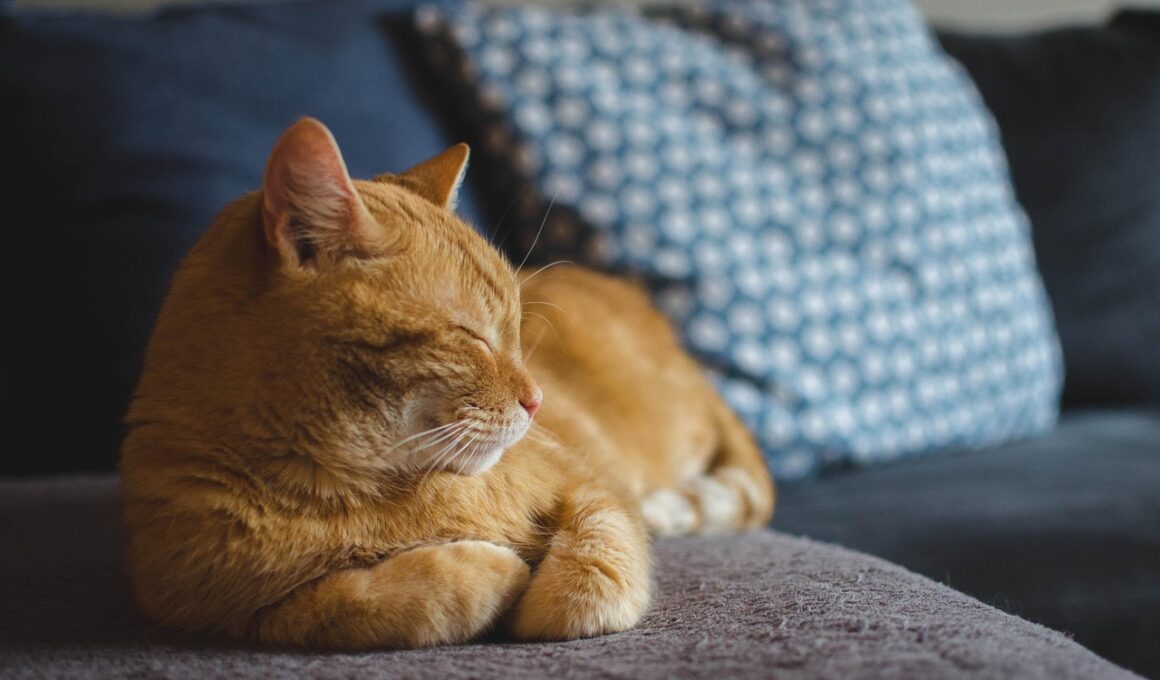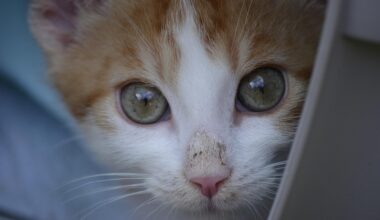How to Calm a Hyperactive Cat: Behavior Modification Techniques
Hyperactive cats can be a source of stress for many owners. Understanding the contributing factors to hyperactivity is essential. Various elements could lead to a cat exhibiting hyperactive behavior. For instance, it could result from a lack of mental or physical stimulation, leading to frustration. Moreover, changes within their environment, such as new pets or moving homes, might disrupt their sense of security. This disruption can lead to excess energy manifesting as hyperactivity. It is crucial to observe your cat’s patterns and habits, taking note of when they seem to act out the most and what triggers this behavior. Do they become more hyper during certain times of the day? Keeping a journal might assist in identifying these trends. Anxiety and stress management are key parts of modification techniques. Cats are creatures of habit, and any changes might provoke unexpected responses. By noting these behaviors, you can develop effective strategies to help calm your overly energetic feline. Also, providing designated play areas helps in encouraging exercise. Creating a routine can vastly improve their behavior and your overall experience with your pet.
Creating a stimulating environment is fundamental when addressing hyperactivity in cats. Cats are natural hunters, and boredom can lead to excessive energy. To combat this, enriching their environment with various toys and climbing structures is beneficial. Items such as scratching posts, interactive toys, and window perches can keep their minds and bodies engaged. Rotation of toys can also maintain their interest, as cats often lose interest quickly. A variety of textures in toys encourages pawing and hunting behavior as well. Implementing scheduled playtime into your daily routine is equally important. Aim for short, frequent play sessions throughout the day to effectively channel that energy. Try creating mini-obstacle courses for your cat, using furniture, boxes, and cushions. Engaging in interactive play with toys like feather wands can provide both physical exercise and mental stimulation. Taking the time to play with them not only benefits them but also strengthens your bond. In addition, consider incorporating technology, such as laser pointers or automated toys, for added engagement. Lastly, always give your cat a quiet, safe space to retreat. This will allow them to release pent-up energy and come back to a calmer state.
Behavior Modification Techniques
Behavior modification techniques focus on changing unwanted behaviors through consistent training methods. Positive reinforcement is the most effective approach. Rewarding your cat for desired behavior can significantly decrease hyperactive tendencies. For every calm moment or when they play gently, provide treats, praise, or affection. This method encourages repetition of the desired behaviors. Consistency in rewarding good behavior promotes learning and adaption. In contrast, avoid punishing them for hyperactivity. Negative reinforcement can cause stress and anxiety, exacerbating their hyperactive tendencies. Instead, create a positive association with calmness. You can also limit their access to areas of excessive stimulation during peak hyperactivity times. Training sessions should be short yet engaging. This prevents overwhelming your cat and fosters a more relaxed demeanor. Consider integrating clicker training to further boost this method. By clicking and rewarding, you provide immediate feedback reinforcing their behavior. Use clear commands to communicate what you want them to do. Whether it’s ‘sit’ or ‘stay’, ensuring your cat understands you is essential in this process. Over time, improvement in their behavior is likely to manifest, leading to a more harmonious home.
Socialization is another important factor in managing hyperactive behavior in cats. Cats that are well-socialized tend to be calmer and less anxious. Introducing your cat to various situations can increase their comfort levels with change, thus reducing hyperactivity triggers. Allowing your cat to experience new environments, sounds, or even different people gradually can help desensitize them to stressors. Ensure positive introductions by using treats and engaging play to associate new experiences with positive outcomes. However, proceed at a pace that your cat is comfortable with; never rush them into uncomfortable situations. Create a sense of security by providing safe spaces where they can observe new experiences without feeling threatened. This gradual approach will help lessen their anxiety. It is crucial to gauge their response at each step and offer support as needed. Providing consistent training and socialization simultaneously ensures a well-rounded approach. This will likely contribute to their overall stability and comfort. If your cat reacts negatively to overwhelming stimuli, retreating to their safe space is entirely normal. Gradually acclimating your cat to social environments can transform their behaviors positively. Eventually, they will exhibit increased confidence and calm that benefits everyone.
Physical Activity and Exercise
Regular physical activity is a cornerstone of managing hyperactive behavior in cats. Exercise helps channel excess energy while also improving muscle tone and overall health. Daily play sessions should include a variety of activities, encouraging your cat to engage and move. Activities such as chasing laser pointers, feather toys, or motorized mice stimulate both their body and mind. Different types of cat toys cater to distinct personalities and energy levels, making experimentation vital. You can also utilize cat-friendly boxes or tunnels to create fun play spaces where they can jump, chase, and explore. Additionally, encouraging outdoor access in a safe, enclosed environment can greatly benefit their behavior. Supervised exploration can satisfy their instinctual need to roam and hunt while allowing you to keep them secure. Be cautious while introducing outdoor play; make sure to supervise at all times and evaluate their behavior progressively. If they seem anxious or overwhelmed, returning indoors is advisable. Integrating these activities consistently into their daily routine will contribute to reducing hyperactive tendencies effectively. Finally, balance physical activity with mental stimulation to maintain a well-rounded approach to their overall behavioral health.
Monitoring your cat’s diet is another crucial element in managing hyperactivity. A balanced and nutritious diet directly influences their energy levels and overall health. Opt for high-quality cat food specifically formulated to meet the nutritional needs for various life stages. Some cats may respond better to grain-free diets or those with higher protein content. Consult your veterinarian for tailored dietary advice suitable for your cat. Food portions should align with their energy levels and metabolic rate, preventing overeating. Additionally, consider feeding them smaller, more frequent meals throughout the day. This pacing can help stabilize their energy levels and reduce hyperactivity. Avoid feeding them too close to playtime, as sudden bursts of energy following a full stomach may lead to hyperactivity. Incorporate interactive feeding methods, such as puzzle feeders, which can stimulate both their mind and their body. A calm eating environment free from distractions also ensures quality mealtime. Monitoring any changes in energy or behavior after dietary adjustments is essential. Finally, keep regular consultation with your vet to maintain the nutritional quality of their food, contributing to a healthier and happier life for your cat.
Consulting Professionals
If hyperactive behavior persists despite your best efforts, consulting a veterinarian or a feline behaviorist may be necessary. Professional advice can prove invaluable in understanding the underlying causes of your cat’s hyperactivity. In some cases, medical issues, such as hyperthyroidism or anxiety disorders, might require professional intervention. A thorough health check can rule out physical conditions that may be contributing to their behavior. Additionally, a feline behaviorist specializes in identifying and assessing behavioral issues. These professionals can support your training efforts by recommending tailored strategies specific to your pet’s needs. They provide insights into behavioral methods often overlooked by owners. Furthermore, if you have multiple pets, they can guide you in managing their interactions effectively. Communication and collaboration with your pet’s doctor are crucial. They can help assess any medical or emotional issues impacting your cat. Working together can ultimately lead to more successful outcomes, allowing you to understand your cat better. It is essential to approach your pet’s care holistically, focusing on their environmental, dietary, and emotional needs to ensure a peaceful home where everyone thrives.
In conclusion, addressing hyperactive behavior in cats requires a multifaceted approach. By understanding the contributing factors and employing various strategies, you can significantly improve your feline’s behavior and overall well-being. Provide a stimulating environment filled with engaging toys, physical exercise, and scheduled playtime. Use positive reinforcement techniques to encourage desired behaviors, while ensuring socialization occurs at a comfortable pace. Adopt a healthy diet and monitoring dietary changes, collaborating with your veterinarian can optimize their health. If hyperactive tendencies persist, seeking professional guidance will help you uncover underlying issues that may hinder their calmness. Remember to be patient, as behavior modification takes time. Each cat is unique, and some may require more time to adapt to changes than others. Regularly assess your cat’s behavior to determine which strategies effectively improve their hyperactivity. Creating a loving and engaging atmosphere for your cat will ultimately lead to a deeper bond and a more harmonious living environment. As you implement these tips, you should see encouraging differences in their behavior. Focus on positive outcomes and be proactive in making necessary adjustments, leading to a more enjoyable life for you and your beloved pet.


